At the peak of the Arctic melt season, ice extent loss has essentially stopped. Green shows areas of increased ice since Sunday, and red shows the opposite.
Disrupting the Borg is expensive and time consuming!
Google Search
-
Recent Posts
- New Visitech Features
- Ice-Free Arctic By 2014
- Debt-Free US Treasury Forecast
- Analyzing Big City Crime (Part 2)
- Analyzing Big City Crime
- UK Migration Caused By Global Warming
- Climate Attribution In Greece
- “Brown: ’50 days to save world'”
- The Catastrophic Influence of Bovine Methane Emissions on Extraterrestrial Climate Patterns
- Posting On X
- Seventeen Years Of Fun
- The Importance Of Good Tools
- Temperature Shifts At Blue Hill, MA
- CO2²
- Time Of Observation Bias
- Climate Scamming For Profit
- Climate Scamming For Profit
- Back To The Future
- “records going back to 1961”
- Analyzing Rainfall At Asheville
- Historical Weather Analysis With Visitech
- “American Summers Are Starting to Feel Like Winter”
- Joker And Midnight Toker
- Cheering Crowds
- Understanding Flood Mechanisms
Recent Comments
- conrad ziefle on Ice-Free Arctic By 2014
- conrad ziefle on Ice-Free Arctic By 2014
- conrad ziefle on Ice-Free Arctic By 2014
- John Francis on Ice-Free Arctic By 2014
- John Francis on Ice-Free Arctic By 2014
- Bob G on New Visitech Features
- Jack the Insider on New Visitech Features
- Bob G on Ice-Free Arctic By 2014
- Mike Peinsipp on Ice-Free Arctic By 2014
- Mike Peinsipp on Ice-Free Arctic By 2014



And the yellow is a special snow cone flavor for Al and Mike.
How can you actually tell from that map what the ice losss / gain is visually? Better to check the calculated data from here
http://www.ijis.iarc.uaf.edu/seaice/extent/plot_v2.csv
Shows ice loss, provisional for today, for last 2 days as
-50552
-78800
Which is neither large nor small. But it does show there is some loss.
Andy
Why bother; you can see the red areas in the picture.